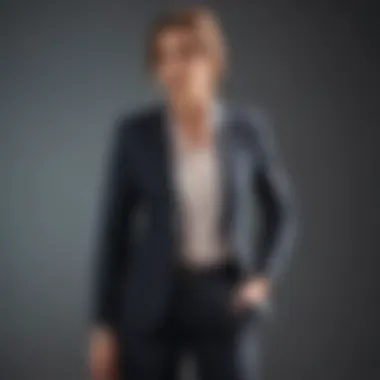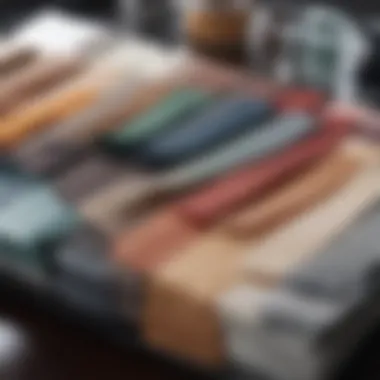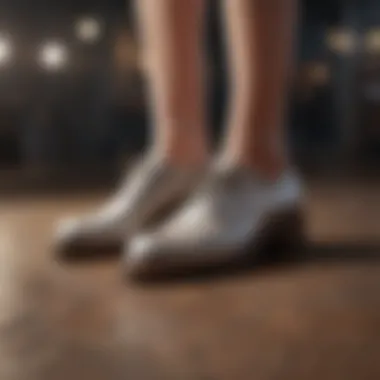Understanding Business Casual Dress Style for Professionals


Intro
In today’s professional landscape, the line between formal and casual attire has blurred significantly. Business casual dress style emerges as a popular choice among many workplaces. This style is not just a trend; it signifies a shift in workplace culture, allowing for personal expression while still adhering to professional standards. Understanding this balance is essential for anyone looking to navigate the modern workplace.
Business casual is often misunderstood. It is neither overly formal nor fully casual, making it a flexible choice. The goal is to appear polished and professional, but also approachable. Many people struggle to define what is appropriate under this category.
As this article unfolds, we will dive deep into the essentials of business casual. Key topics will include its origins, essential elements for both men and women, and practical tips for creating a successful, stylish ensemble. We will also explore common mistakes to avoid and ways to incorporate personal touches that align with the professional environment.
Ultimately, this guide aims to empower readers with knowledge about fabric choice, color coordination, and accessories, enhancing their understanding of business casual attire. Let's begin by looking at some trending topics that illustrate the current landscape of business casual dress style.
The Evolution of Business Casual
Business casual has evolved from a rigid corporate dress code to a flexible style that embodies modern professionalism. This evolution reflects significant cultural and societal changes in the workplace. In this section, we explore critical aspects of business casual, helping readers understand its origin and relevance.
Defining Business Casual
At its core, business casual is a hybrid style combining elements of formal office wear and personal comfort. It allows professionals to present themselves in a way that is both approachable and polished. The defining characteristic of business casual is its ability to strike a balance. For women, this often translates to tailored blouses, dress slacks, or knee-length dresses paired with smart shoes. Men may opt for collared shirts, chinos, or dress trousers without needing to wear a tie. The aim is to look put together while remaining comfortable, facilitating productivity without sacrificing professionalism.
Historical Context
The roots of business casual can be traced back to the 1970s, when companies began to relax their traditional dress codes. This shift was influenced by the growing emphasis on creativity and individuality in the workplace. Tech companies, in particular, adopted a more laid-back approach, promoting a casual atmosphere that encouraged innovation. Over time, the boundaries blurred between professional and casual attire. By the 1990s, business casual became a mainstream concept, adopted by various industries.
Cultural Differences
Business casual is not a one-size-fits-all concept. Cultural norms play a significant role in shaping what is considered appropriate. For instance, in the United States, business casual often permits more relaxed attire compared to countries like Japan, where business etiquette emphasizes formality. Additionally, industries have differing expectations; the tech sector might embrace casual clothing like jeans and sneakers, while finance organizations may require more traditional styles. Understanding these cultural nuances is essential for anyone navigating business casual dress, as it helps in aligning personal style with professional expectations.
"Business casual represents a significant shift in how professionals can express individuality while adhering to workplace standards, but cultural perceptions of attire differ vastly across the globe."
In summary, the evolution of business casual reflects broader changes in workplace culture, allowing professionals to express their identity while maintaining appropriate standards. Understanding its definition, historical context, and cultural differences prepares individuals to dress thoughtfully within this evolving landscape.
Key Components of Business Casual
Understanding the key components of business casual is essential for anyone navigating today's professional landscape. This dress code embodies a blend of professionalism and personal expression, allowing individuals to maintain a polished appearance while integrating elements of comfort and style. Such a balance enhances confidence in the workplace and reflects one's personality without undermining workplace norms.
When considering business casual, several specific elements come into play. The garments worn should not only adhere to company guidelines but should also project competence. Moreover, the adaptability of these pieces offers individuals opportunities to express themselves while remaining appropriate for various settings.
Essential Garments for Women
The essential garments for women in the business casual realm offer a wide array of choices. A well-tailored blazer can instantly upgrade a simple outfit, making it appear more professional. Pairing it with a blouse provides a smart yet comfortable top option. Blouses made from breathable fabrics like cotton or silk drape beautifully and come in various colors and patterns.
Pants are equally important. Tailored trousers or well-fitted chinos fulfill the criteria of being both stylish and professional. Skirts that fall at or below the knee also work well, especially when paired with tights in cooler weather. Dresses that are not overly casual can serve as well, provided they are modest and suitable for the office.
Footwear also plays a crucial role in completing the look. Closed-toe flats or mid-heeled shoes contribute to an overall polished image. It's advisable to avoid overly edgy designs or athletic shoes, as they may detract from a professional appearance.
Essential Garments for Men
Men's essential garments in business casual styles similarly prioritize both comfort and professionalism. The cornerstone piece is often a well-fitted dress shirt, ideally in solid colors or subtle patterns. This can be paired with chinos or tailored trousers. Unlike traditional business wear, ties are typically optional in a business casual setting.
A blazer can provide an additional layer of professionalism without being too formal. It's important that this piece fits well and is neutral in tone, allowing for versatility.


Regarding footwear, loafers or other smart-casual shoes are often the best choices. They should be clean and presentable, avoiding styles that are overly casual, such as sneakers.
The essence of business casual lies in the careful selection of highlight pieces that convey professionalism while allowing personal style to shine through.
Color and Fabric Choices
Color and fabric choices are pivotal in the realm of business casual attire. These elements not only contribute to the overall aesthetics of an outfit but also affect the perception of professionalism. Selecting the right colors and fabrics allows individuals to create a wardrobe that resonates well within their work environment while also reflecting personal style.
Understanding Color Palettes
Color palettes play a central role in business casual dress. Choosing the right colors can enhance one's appearance and convey confidence.
- Neutral Tones: Shades like navy, gray, beige, and white are staples. These colors are versatile and pair well with many outfits. They tend to exude professionalism, making them suitable for various business environments.
- Accent Colors: Incorporating pops of color can bring life to otherwise neutral outfits. Consider softer hues, such as pastel blues or muted greens, which remain professional while adding a bit of personality.
- Avoiding Overly Bright Colors: While vibrancy can be engaging, overly bright colors often distract in professional settings. It's essential to strike a balance.
- Seasonal Adjustments: Seasonal colors, such as earth tones in fall and lighter shades in summer, may also affect perception. Adapting color choices to the season signifies awareness of context and style.
Selecting Appropriate Fabrics
When it comes to fabrics, the choice can influence comfort, durability, and overall impression. Understanding which fabrics convey a business casual look is essential. Here are several considerations:
- Cotton: A breathable fabric, cotton is comfortable and looks polished. It is suitable for shirts, blouses, and trousers. Look for higher thread counts to maintain a more refined appearance.
- Wool: Lightweight wool blends are perfect for structured garments. They offer warmth without bulk, making them ideal for blazers and tailored trousers.
- Blends: Fabric blends with polyester or spandex provide stretch and durability. These materials resist wrinkling, making them suitable for long workdays.
- Avoiding Casual Fabrics: Materials like denim or jersey, while comfortable, may not always align with business casual standards. They give off a more relaxed vibe, which may not be appropriate in all work environments.
"Proper attention to color and fabric selections can significantly enhance one’s ability to navigate the complexities of business casual dress while maintaining professionalism."
Accessorizing Business Casual
Accessorizing business casual attire is often an overlooked yet critical aspect of pulling together an outfit. The right accessories can elevate an otherwise standard look, adding a touch of personality while still adhering to the professional aesthetic. Accessories serve not only a functional purpose but also reflect personal style and individuality, helping to convey the wearer’s professionalism and confidence. Balance is key; the goal is to enhance without overshadowing the overall business casual vibe.
Choosing the Right Accessories
When considering accessories for business casual, the focus should be on pieces that complement the outfit without making it too formal or too casual. Simple jewelry, such as stud earrings or a delicate necklace, tends to work well. Consider the following:
- Materials: Opt for materials like silver, gold, or even high-quality costume jewelry to keep it professional.
- Size and Scale: Avoid overly large or loud accessories that could distract. Instead, aim for modest sizes that provide visual interest.
- Functionality: A chic watch or a stylish tote bag can be both decorative and practical. Ensure your accessories serve a purpose as well.
Accessories can also range from scarves to belts that incorporate subtle colors or patterns to create cohesion with your overall look.
Footwear Considerations
Footwear plays a vital role in defining business casual style. Choosing the right shoes can significantly impact the overall impression you make. Here are some options:
- Closed-Toe Flats: Ideal for both comfort and style, closed-toe flats often pair well with various outfits. They are appropriate for many workplace environments.
- Low Heels: A low heel provides a polished look while remaining comfortable for all-day wear. They can add a slightly elevated touch to your ensemble.
- Smart Sneakers: In some casual work environments, clean and minimalist sneakers can fit within the business casual dress code. Options such as white leather sneakers can keep you stylish while maintaining that casual feel.
- Boots: Depending on the season, ankle boots can be an excellent choice. Opt for understated styles that align with your overall outfit.
It is essential to ensure your shoes are clean and in good condition. Footwear can make or break an outfit, so careful selection is necessary to maintain professionalism while expressing personal style.
Common Missteps to Avoid
In the realm of business casual attire, nailing the right look can feel challenging. Yet, many still make crucial errors that detract from a professional image. Identifying and avoiding these common missteps is essential for any professional trying to navigate the complexities of dressing appropriately in today's workplace.
Overdressing or Underdressing
One major pitfall is overdressing or underdressing for the specific work environment. Overdressing occurs when an individual wears more formal attire than the occasion calls for. This is particularly noticeable in environments with relaxed dress codes. For instance, if most colleagues wear chinos and blouses, showing up in a tailored suit can create discomfort or send the wrong message.
Conversely, underdressing involves wearing too casual outfits that may undermine professionalism. Wearing flip-flops, shorts, or overly graphic tees can result in a lack of credibility. Both overdressing and underdressing can impact not only one's personal brand but also how colleagues perceive their professionalism.


To avoid these missteps, consider the following steps:
- Observe your colleagues: Pay attention to what your peers wear regularly. This can provide valuable insights into the expected dress code.
- Consult dress code guidelines: Familiarize yourself with the company's dress code policies, if available. This can usually be found in employee handbooks or by asking HR.
- Aim for balance: Strive to choose outfits that align closely with what your work environment typically maintains without pushing too far into formal or casual extremes.
Inappropriate Patterns and Graphics
Another common mistake is the selection of inappropriate patterns and graphics. Choosing bold or distracting patterns can divert attention from the professional message one is trying to convey. Similarly, graphics that may be considered humorous or controversial can offend or confuse colleagues.
For instance, wearing a shirt with an overly loud pattern can make it challenging for others to take one seriously. Patterns should tend to be more subtle or understated unless the work environment encourages more expressive styles. On the other hand, graphics featuring branding or logos unrelated to work can detract from the individual’s credibility.
Here are some tips to navigate pattern and graphic choices:
- Stick to classic patterns: Opt for pinstripes, plaids, or polka dots that can maintain a professional image without overwhelming the visual aesthetic.
- Avoid overly casual graphics: Choose clothing that reflects professionalism. Avoid t-shirts emblazoned with band names or slogans that may not resonate with colleagues.
- Test new patterns cautiously: If considering a new pattern, consider wearing it once in a casual situation first to gauge feedback from peers.
Ultimately, avoiding these common missteps ensures that business casual style remains a true reflection of professionalism while still allowing individuals to express their personal style effectively. By understanding the nuances of appropriateness in dress, individuals can navigate the often-ambiguous business casual environment with confidence.
Business Casual for Various Occasions
The concept of business casual dress style is not just a uniform for the workplace; it is a reflection of professional etiquette that adapts to various environments. Understanding how to apply business casual attire appropriately across different occasions is essential for anyone aiming to navigate their professional surroundings effectively. From daily office wear to networking events, your choice of clothing should communicate respect for the setting while also allowing for personal expression.
Daily Office Wear
Daily office wear sets the tone for a productive day. It is vital to choose garments that balance comfort and professionalism. Opting for tailored trousers with a simple blouse or a smart-casual dress can create a polished look that is appropriate for an everyday office environment. Colors should be neutral, allowing for versatility, while comfortable fabrics can enhance focus throughout long hours at a desk. Wearing subtle accessories can elevate the outfit without drawing excessive attention, thus maintaining a professional aura.
Client Meetings
Client meetings present a unique challenge where the stakes are often higher in terms of first impressions. When dressing for these interactions, the attire should strike a balance between formal and relaxed, demonstrating respect for both the client and the business environment. A blazer over a fitted shirt or a sophisticated dress are excellent choices. Consider the atmosphere of the meeting; a tech firm may lean towards a more relaxed interpretation of business casual, while a financial institution might favor a more polished look. Accessorizing with understated jewelry and choosing shoes that marry comfort with elegance is also advisable, ensuring readiness for sitting or standing for prolonged periods.
Networking Events
Networking events are crucial for professional growth. Here, business casual style allows for personal flair while remaining appropriate. Choose outfits that express your individuality, such as a unique top paired with classic trousers or a bold pattern that maintains a professional look. Footwear can range from smart flats to low heels, depending on the venue and your personal comfort. The goal is to create a positive impression and facilitate connections. Therefore, dressing in a way that makes you feel confident can foster more engaging and authentic interactions with others.
Understanding the context of each occasion is key when selecting your business casual attire.
In summary, mastering business casual for various occasions is a skill that reflects a deep understanding of workplace norms. Being able to switch outfits based on the environment shows adaptability and respect for both personal style and professional standards.
Incorporating Personal Style
In the realm of business casual attire, the integration of personal style serves as a critical bridge between individual expression and professional expectations. Understanding how to incorporate one's personal aesthetic is vital for modern professionals who wish to maintain their uniqueness while adhering to workplace standards. This approach not only enhances personal confidence but also fosters a more vibrant and diverse professional environment.
Balancing Trends with Professionalism
Finding the equilibrium between current fashion trends and the needed professionalism can be complex. Trends fluctuate rapidly, often leaving individuals to question what is appropriate within a workplace setting. One practical strategy is to select one or two trendy pieces and balance them with classic staples. For example, integrating a trendy blouse with a tailored blazer can create a seamless transition between personal style and professional appearance.
Additionally, consider the role of colors and patterns. While bold colors might be trendy, it is important to ensure that they fit within workplace norms. Neutral shades typically remain safe bets, allowing bright accessories or statement pieces to add flair without overwhelming the outfit. This creates a polished look that respects the workplace while still allowing for personal expression.
Expressing Individuality through Accessories
Accessories are essential tools for personal expression in business casual attire. They allow individuals to include elements of their personality without compromising professionalism. The goal is to choose accessories that align with both the individual's unique style and the environment in which one works.


For example, a stunning watch or unique piece of jewelry can serve as conversation starters and reflect personal taste.
Some effective accessories include:
- Scarves: These can enhance any outfit during colder months.
- Statement Necklaces: Bold necklaces can draw attention while still looking professional when paired appropriately.
- Bags: A stylish, functional bag can tie together a look.
Ultimately, when selecting accessories, consider their size and brightness. A simpler design might be more fitting in formal situations, while more vibrant pieces can shine in less conservative environments.
Dress Code Policies and Variability
Dress code policies are essential for any professional setting. They provide guidance on expected attire, helping to maintain a consistent and appropriate atmosphere within the workplace. Business casual is often subject to interpretation, and understanding these policies is vital for individuals navigating this space. A well-defined dress code helps employees understand what is acceptable, fostering an environment where people feel comfortable yet professional.
Understanding Workplace Policies
Workplace policies vary significantly across industries. Some companies have specific guidelines on what constitutes business casual attire, while others may offer more flexibility. For instance, a tech startup might encourage more casual clothing, while a law firm might adopt a stricter approach. Therefore, it is crucial to consult the company handbook or human resources department to clarify the dress code.
Common components of workplace dress codes include:
- Type of attire: Specifics on what is considered business casual.
- Color guidelines: Whether certain colors are appropriate or discouraged.
- Footwear rules: Requirements on types of shoes that can be worn.
This understanding ensures that employees communicate their professionalism while embracing the flexibility offered by business casual. It can also prevent unintentional missteps that may arise from misunderstandings about the dress code.
Adapting to Company Culture
Company culture plays a significant role in how dress code policies are implemented. Different companies have unique environments that reflect their core values and operational styles. For instance, a firm that values creativity may encourage a more relaxed approach to business casual, allowing employees to express their personality through clothing. Conversely, a corporate environment emphasizing tradition may lean toward conservative attire.
To successfully adapt to company culture:
- Observe your environment: Take note of how colleagues dress on a day-to-day basis.
- Seek feedback: Don’t hesitate to ask peers or supervisors about their views on acceptable attire.
- Start with basics: If unsure, begin with more traditional business casual pieces and adjust based on what you observe.
In addition, understanding cultural nuances can influence attire suitable for different regions or international offices. Adapting to company culture not only helps with compliance but also enhances your presence within the organization, allowing for better networking and collaboration.
"Adhering to workplace policies while infusing a touch of personal style can significantly impact how you are perceived in the professional realm."
The Future of Business Casual
As workplaces evolve, so too does the concept of business casual. Its importance lies in the balance it strikes between professionalism and comfort, which is increasingly becoming essential in modern work environments. Understanding this balance is crucial for professionals. With a shifting landscape influenced by various factors, the future of business casual promises to reflect broader cultural and societal changes.
Emerging Trends
Several trends are surfacing that will shape the business casual dress code. For instance, there is a noticeable shift towards sustainability in fashion. More companies are encouraging their employees to wear clothing that is not only stylish but also environmentally friendly. Fabrics made from recycled materials or organic fibers are becoming increasingly popular. This trend speaks to a growing awareness of climate issues and the role fashion can play in fostering a more sustainable future.
In addition, remote work has greatly influenced what business casual means. Professionals are adopting a hybrid work model, which allows for a more relaxed approach to dressing. This is reflected in the style choices that blend comfort with professionalism. Loose-fitting clothing, athleisure wear, and smart-casual outfits are gaining acceptance as legitimate options for work attire.
Ultimately, the blending of comfort and style appears to be a defining characteristic of future business casual attire. Companies may also start to define their dress codes more loosely, giving employees more freedom to express themselves. This evolution, while aimed at comfort, still maintains an undercurrent of professionalism that is essential in corporate settings.
"The lines between formal and casual continue to blur, fostering an environment of creativity and individual expression while retaining professionalism."
Impact of Remote Work
Remote work has significantly altered the perception of business casual. The traditional office setting once dictated stiff dress codes, but virtual meetings have shifted this framework. Many employees now opt for attire that prioritizes comfort while appearing appropriate on video calls. Smart tops paired with casual bottoms have become a staple.
This impact also touches on workplace dynamics. Companies recognize the need to adapt their dress code policies to accommodate employees' preferences, leading to a more inclusive workplace culture.
On another note, while remote work encourages flexibility, it also presents challenges. Professionals must still exhibit a level of professionalism, even from a distance. It is essential for remote employees to choose outfits that maintain respect for their roles and projects, reinforcing the importance of business casual in these settings.
To summarize, the future of business casual hinges on emerging trends towards sustainability and the flexibility brought on by remote work. It promises to be an evolving tapestry of styles that combines comfort and professionalism, making it a relevant and vital part of the modern workforce.



